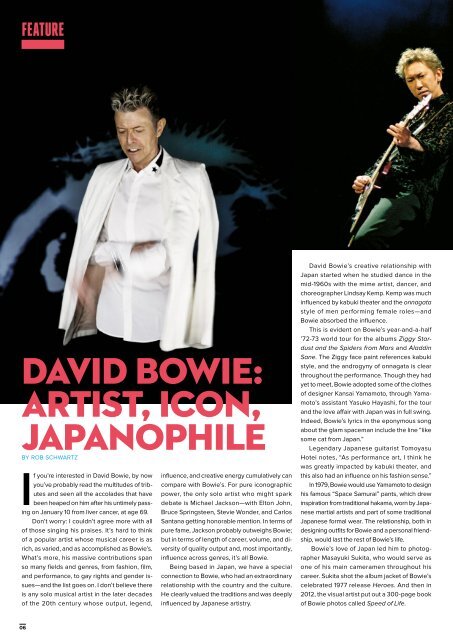DAVID BOWIE
1lVsfhZ
1lVsfhZ
Create successful ePaper yourself
Turn your PDF publications into a flip-book with our unique Google optimized e-Paper software.
FEATURE<br />
<strong>DAVID</strong> <strong>BOWIE</strong>:<br />
ARTIST, ICON,<br />
JAPANOPHILE<br />
BY ROB SCHWARTZ<br />
If you’re interested in David Bowie, by now<br />
you’ve probably read the multitudes of tributes<br />
and seen all the accolades that have<br />
been heaped on him after his untimely passing<br />
on January 10 from liver cancer, at age 69.<br />
Don’t worry: I couldn’t agree more with all<br />
of those singing his praises. It’s hard to think<br />
of a popular artist whose musical career is as<br />
rich, as varied, and as accomplished as Bowie’s.<br />
What’s more, his massive contributions span<br />
so many fields and genres, from fashion, film,<br />
and performance, to gay rights and gender issues—and<br />
the list goes on. I don’t believe there<br />
is any solo musical artist in the later decades<br />
of the 20th century whose output, legend,<br />
influence, and creative energy cumulatively can<br />
compare with Bowie’s. For pure iconographic<br />
power, the only solo artist who might spark<br />
debate is Michael Jackson—with Elton John,<br />
Bruce Springsteen, Stevie Wonder, and Carlos<br />
Santana getting honorable mention. In terms of<br />
pure fame, Jackson probably outweighs Bowie;<br />
but in terms of length of career, volume, and diversity<br />
of quality output and, most importantly,<br />
influence across genres, it’s all Bowie.<br />
Being based in Japan, we have a special<br />
connection to Bowie, who had an extraordinary<br />
relationship with the country and the culture.<br />
He clearly valued the traditions and was deeply<br />
influenced by Japanese artistry.<br />
David Bowie’s creative relationship with<br />
Japan started when he studied dance in the<br />
mid-1960s with the mime artist, dancer, and<br />
choreographer Lindsay Kemp. Kemp was much<br />
influenced by kabuki theater and the onnagata<br />
style of men performing female roles—and<br />
Bowie absorbed the influence.<br />
This is evident on Bowie’s year-and-a-half<br />
’72-73 world tour for the albums Ziggy Stardust<br />
and the Spiders from Mars and Aladdin<br />
Sane. The Ziggy face paint references kabuki<br />
style, and the androgyny of onnagata is clear<br />
throughout the performance. Though they had<br />
yet to meet, Bowie adopted some of the clothes<br />
of designer Kansai Yamamoto, through Yamamoto’s<br />
assistant Yasuko Hayashi, for the tour<br />
and the love affair with Japan was in full swing.<br />
Indeed, Bowie’s lyrics in the eponymous song<br />
about the glam spaceman include the line “like<br />
some cat from Japan.”<br />
Legendary Japanese guitarist Tomoyasu<br />
Hotei notes, “As performance art, I think he<br />
was greatly impacted by kabuki theater, and<br />
this also had an influence on his fashion sense.”<br />
In 1979, Bowie would use Yamamoto to design<br />
his famous “Space Samurai” pants, which drew<br />
inspiration from traditional hakama, worn by Japanese<br />
martial artists and part of some traditional<br />
Japanese formal wear. The relationship, both in<br />
designing outfits for Bowie and a personal friendship,<br />
would last the rest of Bowie’s life.<br />
Bowie’s love of Japan led him to photographer<br />
Masayuki Sukita, who would serve as<br />
one of his main cameramen throughout his<br />
career. Sukita shot the album jacket of Bowie’s<br />
celebrated 1977 release Heroes. And then in<br />
2012, the visual artist put out a 300-page book<br />
of Bowie photos called Speed of Life.<br />
06


